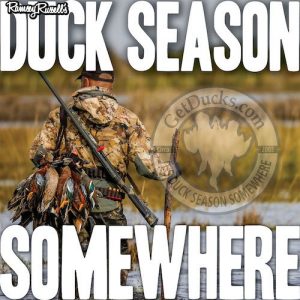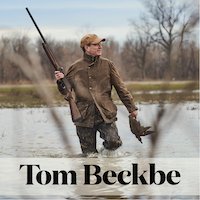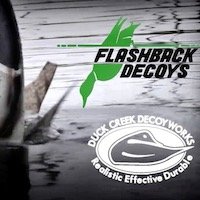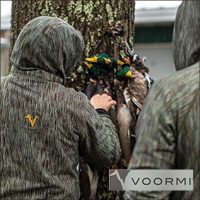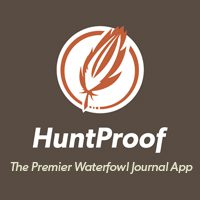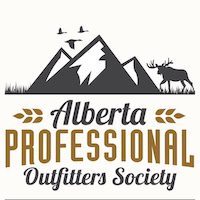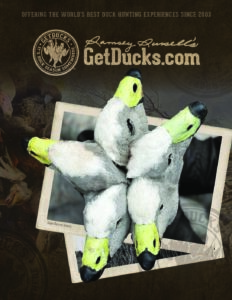What kind of migration might you expect to see this duck season? FowlWeather Podcast host, Michael Schummer, returns to give us the lowdown on this year’s migration forecast, explaining how and why his forecast indices were developed, important cues to monitor, how to stay updated weekly, and relevance to both anxious duck hunters and to continuing science-based, hunter-oriented waterfowl management. By the time this special episode airs, the US waterfowl hunting season will be ongoing nearly nationwide, and this conversation offers food for thought while awaiting waterfowl over your decoys!
Ramsey Russell: Welcome back to MoJo’s Duck Season Somewhere podcast. I am in Maryland, wrapping up an epic North American tour this year. On the line with my buddy Michael Schumer, proud Mississippi State graduate from back in the day, and also host of the Foul Weather podcast. You all be sure to check it out. He does a deep dive, a weekly dive, into what we’re gonna talk about today. As we record today, you’re probably heading to grandma’s for Thanksgiving or going to camp for Thanksgiving. Duck season is open or opening tomorrow throughout the entire United States of America. It’s our time of year. Becomes the question. What are you seeing out there in the duck counts? Where in the hell are the ducks? Mike, how you doing, man?
Michael Schumer: I’m good, Ramsey. Thanks for having me on again.
Ramsey Russell: Always good to have you, Mike. You know, it’s been a very, very interesting year, eye-opening season for me so far. I left home September 13th. We’re recording this thing in November now, and it’s been a very interesting year. It looks to me like the migration is lining up almost exactly like last year, which seems so far like the duck season that winter forgot again. What are you seeing? What are you thinking? How are things going up in your neck of the woods so far?
Michael Schumer: “Last year in October, there was that cold front around the 20th, cold and snow all the way down through the Dakotas, and then everything just came to a screeching halt and got warm.”
Michael Schumer: I have optimism, because you have to, right? You gotta be optimistic, take what each season gives to you. But yeah, you’re kind of right. I mean, last year, and you’re gonna be able to tell us, and I’m gonna ask you what you’ve been seeing as you’ve traveled around. But like last year in October, there was that cold front around the 20th, cold and snow all the way down through the Dakotas, and then everything just came to a screeching halt and got warm. And we haven’t seen that real cold yet. We haven’t seen that snow. I think by the time this broadcasts, we’re going to have that snow. It’s called for down into South Dakota a little bit, three to four inches, some cold. But my estimation is last year, you know, real quick cold, then got warm. This year’s has stayed really warm. October across this country was the 129th warmest in 130 years on record.
Ramsey Russell: Wow.
Michael Schumer: Yeah. So when people say, “Where the hell are the ducks?”, and that’s a comment from a lot of people still this year, right? it’s been warm, and there’s not a lot you can do about that. But what I see is a progression in the cold weather that didn’t happen last year. And my expectation is that folks, you know, you get into, maybe not right, you’re going to have some early ducks, what people call calendar ducks, for that early period. But by the time you get into Christmas, I think you’re going to be sitting, my hope is you’re sitting pretty. Like last year, Deep South, those ducks didn’t show up. They didn’t show up, but when they did, it was like, what, the last two weeks of the season?
Ramsey Russell: Yeah, it’s warm. There’s no denying. Call it global warming, call it environmental trends, call it what you want, by God, we’re warming up in the Northern Hemisphere. And also drought. You talk about snow, that’s precipitation. And man, what I’m seeing right here, having been clear out to Alberta, now clear over to all the way to Prince Edward Island, down to Maryland, best I can tell, we’re in a continental drought right now. And it slapped me in the face. Pulling up into prairie Canada out west this year, dry, dry, dry, dry, dry, dry. It’s unbelievably dry.
Michael Schumer: It is bad. Even here on our local news, you know, we’re in central New York, Finger Lakes region, kind of Great Lakes region, we don’t hear about drought that much, right. But even folks here on the local news are talking about, you know, a moderate to strong drought for us. And so we’ve seen that, plus really, really mild conditions. I’d say 80% of our mallards are still in Canada, right? We’ve shot our local stuff, but those haven’t shown up. We’ve had some of our early migrants leave. If anything, the Atlantic Flyway is where it’s not right now. If you look across the country, we’ve been warmer longer here than anywhere else.
Ramsey Russell: Yeah, I was a little optimistic. Where was I? I was in P.E.I. my last day in Canada, and we hit some snow. It was brisk. It was fresh, I would call it out there. It wasn’t cold-cold, but it was fresh. And it was more like sleet than snow. It was just hard and coming in, felt like wintertime coming. But it’s since warmed up, you know, it’s since warmed up big time. It’s disappointing. But, you know, I heard about the drought and then I heard and saw rumors that we had shaken out of it a little bit, that they got some late precipitation up on the prairie that was better than nothing. But when I drove up to Saskatchewan, it was Saskatchewan, then over to Manitoba, back to Saskatchewan, Alberta, jumped down, went to Ontario, New Brunswick, P.E.I., everybody’s dry. And I just didn’t realize, appreciate, you know, how dry it was until I got back up to Saskatchewan. Expected to see it a little bit better than last year, but it was anything but. It was, and what’s so disheartening for the future is the amount of dirt work I saw going on. The dirt pans, the tiling, disking over the wetlands, it was crazy dry. And it began to be expressed. There were big areas with no ducks because there was no water. There were big areas with a lot of ducks because there was some water for them to congregate in. Weather-wise, temperature-wise, these cold fronts and stuff, I’m trying to lead up into kind of your foul weather forecast is, it seemed like a lot of the migration, the continental goose migration, or I should say Arctic goose migration, was behind. The snows were late, which, you know, I kind of think of them as a photoperiod migrator. They were late. I was talking to somebody last night, I can’t remember when he said he was out west, but they got into the Ross geese. And you know, I use that Hunt Proof app to document bag limits retrieve, but also species. And notably absent this year from our bag was Ross geese. You know, we get them, but not like last year. Something was up. Now, I will say there seemed to be a whole lot of gray birds, you know? And I don’t mean just in the bag, I expect to see heavy bags of gray birds, but boy, I tell you what, glassing those fields, it seemed to me like the snow geese had a pretty good hatch. I saw lots of gray birds out there in those flocks, but they were late getting in this year.
Michael Schumer: So back to the water thing. First of all, the Canadian prairies did not fare as well as the U.S. prairies when that rain came in May, June, July, right. So I was in North Dakota for 10 days, and we had reasonable, what I would say is reasonable water, right. Compared to when I was in South Dakota in the late 1990s, nothing like that. But a lot of it continues to be, you know, permanent and semi-permanent basins. Then some of the more temporary stuff actually started to have some water in it. But that kind of dies as you get into southern Manitoba. You get a little bit of it. The rest of the Canadian prairies, we think of pintail territory and some of that super-productive stuff or the other dabbling ducks. That stuff is still really, really dry, Ramsey. And then on the goose front, I mean, I talked with Chris Nicolai. He was on our podcast, the Fowl Weather podcast there. I don’t know, I want to say like a month ago or so. It’s probably been, yeah, three or four weeks ago, you know, and his comment was, you know, if you’re here now, you’re way early for geese normally, and this year you’re way, way early. So, yeah, you hit it on the head. The goose migration has been generally behind, but I did talk with, text back and forth with Heath Hagee this morning. I was in the deer stand and, you know, trying to put more venison in the freezer. And he said, he gave me a little anecdotal update, and he said a lot of the snow geese, he thought, had left around the Bismarck region. So maybe they’re back on track a little bit. Because I remember last year, you saying, I mean, it was, you had snows in Alberta in, when, late November. Really?
Ramsey Russell: No. Some of our outfitters were shooting snow geese on December 18, the last day of the Alberta season.
Michael Schumer: Yeah. That’s crazy.
Ramsey Russell: That’s crazy. And I’m still here. And here we are, first week of November, and down the southern tier, they’ve still got a lot of birds. I know that up in central Alberta, they’re starting to get some snow. But now I know I’ll get death threats for saying this, but, man, it would not hurt my feelings at all if I saw on the Weather Channel that Canada, from British Columbia clear out to P.E.I., the entire Canada, all of Canada, had snow up to the rooflines. I’m talking feet, meters of snow I’d like to see that in that country. You know what, how that little bit of lake-plus precipitation. It seems like in early September, late August, somewhere in that time frame, they caught about a 3-inch rain out in Saskatchewan, sounds great, doesn’t it? No, it didn’t do anything.
Michael Schumer: It’s up like a sponge.
Ramsey Russell: But I’ll tell you what it did. I talked to a farmer who said that they did not have record crop production. They didn’t get the precipitation they needed for bumper grain production this year, but they made a crop. And, you know, typically when they go out and combine it, it leaves little waste grain out there. What I saw, wall-to-wall throughout the western Canada landscape, was they got just enough rain. Just like a Deep South dove field. You get that big rain before dove season opens, it sprouts all the grain.
Michael Schumer: And it was that warm.
Ramsey Russell: It looked like green fields out there. And what that equated to, you know, I think it made the snow goose hunting, I’m up there, boy, chasing those snows out west. I love shooting snow geese up in Canada, but, you know, those birds are not programmed to eat green this time of year. They’re hitting those fields, wanting grain to carbo-load for the migration. So, you know, countless scouting reports we’d put 5 or 10 or 15,000 geese to bed on a field and show up the next morning and sit there, and I’d not see a bird within a mile and a half because they were just jump, jump, jump, jump, jump, jump, jump. They were hitting and moving, just trying to find grain. And it made pinning them down to the mat really, really tough this year. So when we did have those good shoots, and we did have a few, it just felt well-deserved. It felt like we put in the time and did everything to make it happen, but it was dismal, man. And the warm weather was not helping. I mean, I think I can count on about six fingers between late September and late October, early November, six fingers, the number of times we actually had a frost. Very, very few times did I have to go out and crank the truck to get the frost off the glass so I could drive, very, very few times. And it’s worrisome, Mike. Now, I want to back up at this point. We’ve been going on and on about Canada, what we’ve been seeing and doing and whatnot. But I want to back up, Mike. And for those that, we’re now on iHeartRadio. We do have a lot of new listeners this year. I just want to back up. You’ve been on here a couple of times before, but I want to introduce you. And with your groundbreaking research, I’d say that you and Kaminski did down at Mississippi State University, and your Fowl Weather podcast and forecast, just kind of bring everybody into where you’re coming from with a lot of your predictions and a lot of your technical background.
Ramsey Russell: “We explained about half of the variation in the movement of ducks with one number… how cold is it on any given day, how much snow is on the ground, and how many days in a row has it been below freezing?”
Michael Schumer: Yeah, it’s a big story. But I’ll try to be brief here, Ramsey, and I’m not known for it, so I apologize. Please cut me off where you need to. But when I got to Mississippi State as a postdoc, I’d done my PhD up in Ontario. I did my master’s degree in the Bootheel in Missouri at Southeast Missouri State and some forestry degrees before that. But I got hooked on ducks and duck hunting and decided to kind of make that into a career. So when I got to Mississippi State as a postdoc, and my wife was there doing her master’s degree, now she works for Ducks Unlimited, the question was at that point, where the hell are all the ducks? And this was at another low. Yeah, right. Like, we’ve been through this before. I’ve covered it on the podcast, and you have as well. But it was, like, around 2005 another bottom for the breeding population for mallards specifically. And everybody, you know, when they say, “Hey, how’s the duck hunting?” they mean mallards, right, in that part of the world. So, you know, Rick Kaminski gave me the reins and said, “Hey, work on whatever you want here.” And I said, “I want to figure out, is it low populations, is it weather? What’s driving these low numbers in the Deep South?” And we went and looked for literature, because all I wanted to do was categorize, has the weather changed as interpreted by a duck or a mallard? And the reality was, as much as we talk about it in the blind and everything, there wasn’t a quantitative way to do that, or we couldn’t pick up a newspaper and look at how much it had snowed and how cold it was to come up with a number to say, “Hey, mallards should be here or they shouldn’t.” And so that’s what we set out to do. We worked with the Missouri Department of Conservation, who has some of the best data out there, and we looked at all these different combinations of weather. Heck, we looked at sunspots, moon phases, all kinds of things, and related that weather to increases or decreases in the numbers of mallards at several locations in Missouri. And what we came up with was: how cold is it on any given day (what’s the mean temperature), how much snow is on the ground, how many days in a row has it been below freezing, and how many days has there been measurable snow that would interfere with field feeding as an index to migration? And that has stuck pretty, pretty darn well. We explained about half of the variation in the movement of ducks with one number, one number, right. So we were pretty happy with that. I went up to Ontario at that time, back to work as a senior scientist with my prior supervisor, Scott Petrie. He’s now the CEO of Delta Waterfowl, but at that time he was a professor still at Western Ontario and had grad students. I worked with other grad students to refine those, what we dubbed, weather severity indices that predicted migration. But what we did is we did more than mallards. So we had the whole suite of dabbling ducks that we were able to explain what types of weather combinations caused them to migrate. So that’s kind of, in a nutshell, what we do now. And what we’re doing is using those weather severity indices on a weekly basis on the Fowl Weather podcast, and we are predicting duck migration, Ramsey, nobody else does that, right. Everyone else gives you reports or they talk to a meteorologist. The meteorologist is like, “Oh, it’s going to get cold, it’s going to snow,” but they can’t, like, I literally, on the podcast this week, was like, on Wednesday, early dabbling ducks are really going to start moving from here to here. And by Friday and Saturday, the mallards should be kind of piling back up over the top of them. And, you know, that’s the stuff that gets me excited, when I see those numbers jump, and I look at the wind and the winds, and north wind, and it’s a full moon, man, you better get ready. And that’s what I’m trying to do, produce information that gives folks with limited time the best days to pick to hunt, right. Our catchphrase is, “Know where the ducks are at before the ducks know where they’re at.”
Ramsey Russell: Right.
Michael Schumer: That’s a fun one. And I think that’s what we do, right. So last year, Ramsey, I went on five days that I picked as, you know, lights-out flight days at the refuge down the road. Four of those hit. I’m shooting ducks coming out of Ontario before their feet ever touch U.S. soil or water.
Ramsey Russell: Wow.
Michael Schumer: Those are the days you live for. And they only happen if you look at it. They only happen just about everywhere four or five days out of the year when it’s like, “Hey, they’re coming, they’re coming.” You know, and those are fun days when they come out of the stratosphere and they make these big circles and they drop right into your decoy spread. That’s what dreams are made of.
Ramsey Russell: You all put together that great big algorithm, the weather severity indices. What were the most critical cues that initiate migration of dabbling ducks?
Michael Schumer: Yeah, so it’s cold and snow. I mean, that’s really what it comes down to. And, I mean, we could throw other things in there and explain it more, but it gets pretty complicated. And I’ve gotten yelled at about this by folks. They’re like, “Well, we can understand barometric pressure and we can understand wind.” And, you know, hunters are like, “We understand all these things.” Fishermen, you know, everybody talks about barometric pressure. But the reality is, like, if you just go to your weather app or a newspaper, you’re going to get snow, you’re going to get precipitation, you’re going to get temperature, right. And so I wanted to make something that was relatively straightforward that explained most of the variation in why these birds are moving. Think about this, Ramsey, and you’ve lived through this. Every day, it’s like the day that it’s cold and how much snow there is affects the immediate energy that that animal, that mallard hunt, can bring in. Can it access food? Is the wetland frozen? Does the field have snow? And then these animals have fat on them too, so they can actually hold that fat and they can sit this stuff out. So then it gets into, how many days in a row is it below freezing? And how many days in a row has there been snow? Because here’s what’s going on, It’s immediately cold, so I’m burning energy. And then over a period of time, I can’t replace that energy because I can’t get food. And at some point, there’s a threshold where the duck says, “Man, I better leave today or I’m going to get stuck here,” right.
So It’s actually like a cumulative weather severity index. It’s kind of like the accumulation of weather. It’s not a single event. It’s the accumulation of days of weather that kind of make them move.
Ramsey Russell: Yeah. You know, if I were watching the weather channel, and I get up every morning, like every duck hunter do, and I look at the weather. What’s the weather going to do? What are we doing outside, doing tomorrow, doing this week? But, you know, I love those weather maps that show those thermocline lines of temperature lines coming down. Is there a thermocline that those ducks are mostly staying in? If I were a duck hunter just looking at it with a fourth-grade level at a thermocline map, how do I make sense of that?
Michael Schumer: So one of the things I will tell you, and I’ve had this question over and over since we came up with the weather severity index, is that the snow and the cold and the length of it, they trade off of each other. So the easy answer is no, you really can’t look at a thermocline. And everybody should just get on Monday morning and listen to the Fowl Weather podcast because we do make those predictions. But if, for whatever reason, you weren’t able to tune in, what we find is that right for mallards specifically, right around when the average temperature, so you take the low and the high temperature for the day and average them out, when that’s around freezing, you should be at peak mallard abundance right.
Ramsey Russell: In my local Zip code, in my local hunting area, it’s around freezing.
Michael Schumer: You should actually be seeing the greatest increase in the numbers of ducks during that time. So this is the other thing that we really work on is forecasting fresh ducks. We say “fresh ducks hot from the north” because your local ducks, Ramsey, once they’ve been there for seven days and figure out where all the guns are, where the blinds are, they don’t get shot.
Ramsey Russell: Right.
Michael Schumer: Yes, you can on weather events locally, but you’re killing, when you get those really good days, you’re killing fresh ducks hot from the north that haven’t seen anything, don’t know where they’re going. They’re trying to figure that landscape out yet. And so right around when your temperature is right around an average of 0 Celsius or 32 degrees Fahrenheit is typically when we see the greatest increases in mallards.
Ramsey Russell: Actually.
Michael Schumer: That’s your easiest one because what that tends to do is correlate up north, a little bit north of you, with that weather severity index that’s at that threshold of enough cold, enough snow that makes them move, right. Usually, when you get the cold, it’s even worse up north.
Ramsey Russell: That’s right. I know you all had this model for a long time, this seasonal forecasting. This year you all added diving ducks, and you also added the Pacific Flyway.
Michael Schumer: Yeah, we’re kind of BS our way through that one. The diving duck stuff is brand new. I’ve got a Ph.D. student that I’m working with, Emily Miller, who’s funded by the state of Kansas. She’s been working generally on how to help refine their waterfowl seasons to understand if their waterfowl seasons are timed well with migration. And so I tasked her with working on weather severity indices for diving ducks. And so we’ve got redheads, cans, and bluebill models right now. And they’re in the experimental phase because they’re not published, right. All this other stuff is kind of public domain and published models. And then we kept getting just so many people asking for Pacific Flyway migration forecasts that I threw it in there with the caveat that all of the models we have built have used data from the Central, Mississippi, and Atlantic Flyways. So people should tell us, “Hey, is this, you know, is this working, right. Are we predicting migration?” I tell you, the good thing is, oh man, the West is winning it this year, right. It’s that La Niña thing. They’ve got snow, they got cold kind of coming into the Pacific Northwest, and it’s a pretty slam-dunk migration. It’s pushing birds. The migration in general right now from west to east is, you know, west being the best and the Atlantic, you know, Pacific being the best, and Atlantic Flyway being the best as far as migration at this point. So I think we just lucked out with the Pacific Flyway being pretty easy for the really good progression of cold and snow that’s moving right now this year. So I don’t know how it’ll hold up. We’d really like to get a partner in the West with a lot of, you know, waterfowl survey data to test out these models. It’s just so different. There’s the Intermountain Region birds, you know, the whole. It’s not like cold just progresses from north to south like it does in the Central, Mississippi, and Atlantic Flyways. The West is weird with the Rocky Mountains and a lot of interference and these weird systems that blow up over, you know, off the coast of Oregon and Washington and British Columbia that just, you know, will dump rain in a period where right after it snows or something, right. And so, and then you got all the rivers like the Snake and the Columbia where ducks just sit stuff out. I mean, it’s frozen, but if they can get off those rivers and go field feed, they’re going to hang there. So, you know, we’re sticking our neck out, but people asked for it. And so we’re giving a prediction. And I’m just saying, and I’ve gotten good reports from Oregon and others. So people are giving us feedback. It’s been good.
Ramsey Russell: Fantastic. Mike, with respect to the seasonal forecast, with what’s going on this coming year, that’s what people are tuning in today to hear is what they can expect to make sense of what they’re seeing so far this season or what they should expect to see if their season is just now fixing to open. For example, I’m in Maryland right now, and last night around a campfire, we were watching ducks flying to a particular field. Boy, did those ducks put on a show. Whoo, did they put on a show. Lots of teal, wood ducks, lots of black ducks, mallards, and some pintails. And a lot of the locals here were commenting that the big ducks were early. They were seeing more big ducks than they expected to see this time of year. What’s going on that they’re perceiving that?
Michael Schumer: More Ducks. The Atlantic Flyway production last year was really good period, I would say. A friend of mine the other day said, “Hey, you should do something on your podcast because there are 5 million mallards out there, and they can’t all be doing the same thing in the traditional survey area.” And that’s where I’m at, right. We are piled up with pintails here.
Spealer_B: Is that normal?
Spealer_B: In early ducks, yeah. We had them last year. It was weird. We had them all the way through winter last year. No, that is not normal. You know, normally, approaching Thanksgiving, my gun season for deer opens. Two days ago, when I grew up, we were in snow. You didn’t need to know how to track a deer because there was snow, and you could just see blood on the snow, right. Now, you gotta be on your hands and knees across green fields and leaves to find the dang thing you hit. It’s different, you know, bow season ends when bow season ends because it’s the separation between when the rut really gets going and gun season and the end of bow season are right around the peak of that rut. But boy, there was snow. And almost always on Thanksgiving, we had a layer of snow. Now, I grew up south of Buffalo, kind of Snow Belt country, Allegheny Plateau stuff. And now I live up in the lake plain, so it’s a little milder here. But my mom still lives there. They haven’t gotten snow, right. So, you know, milder for sure. We’re in our second split. This is nice, Ramsey. I get to deer hunt for like two, three weeks because we get this split that’s right in the middle of the rut. And I know you’re just a straight bird hunter, but I’m a passionate deer hunter.
Ramsey Russell: Oh, I did hunt a little bit. Not much, but a little bit.
Michael Schumer: Okay, I don’t want to throw you under the bus. So, Ramsey deer hunts a little, but it’s become a thing for us, mostly because of the farm here. We’ve got some reasonable opportunities, right, that we’ve grown to love. But our second season doesn’t open until the 5th, 6th, or 7th of December, and we run till the first week in January in New York now. Our mallard migration typically doesn’t peak until the second week of December.
Ramsey Russell: Yeah.
Michael Schumer: In 1910, Elon Eaton, who wrote The Birds of New York, it’s a book about 3 inches thick with insanely dense information, mentioned the peak of mallard and black duck migration in 1910 was the first week of November. So, stuff’s changing, as you said. I don’t even, like on the podcast, touch this stuff. I’m like, “I don’t care why it’s changing, it’s changing,” right?
Ramsey Russell: Right.
Michael Schumer: But it still varies year to year. Like this year, I mean, we’ve got our refuge next door to us. Ramsey, it’s covered in canvasbacks and redheads. I don’t know where they came from.
Ramsey Russell: Why is it covered up all of a sudden? What is your algorithm showing? What is the difference between this year and last year?
Michael Schumer: Well, they should be in. Chris Nicol noted this. He’s like, “They left the prairies quick.” You know, they were on the upper Mississippi. The cans were really quick.
Ramsey Russell: That may have been a function of water.
Michael Schumer: I think it could be, too.
Ramsey Russell: They’re flying, looking for habitat.
Michael Schumer: I think they are, yeah. The refuge pool now has been filled for two. They do the emergent marsh cycle, where they drain it, grow moist soil, let the cattail come back, the muskrats eat it, it opens back up, and then it’s an open pool for a while. And they’re moving into that open pool phase. When they do that, they grow wild celery.
Ramsey Russell: Yeah.
Michael Schumer: And tons of other aquatic vegetation. And I think what’s happening is that whatever birds we have have found a massive food source at this point. That’s probably what’s going on.But this is where the weather severity index works in general, right? We are behind schedule for migration for sure. The weather severity index for this week and next week, coming up to Thanksgiving, says, “Hey, stuff should really be on the move.” And if your season opens around Thanksgiving, which a lot of folks do in the south, you should be better off than last year, Ramsey.
Ramsey Russell: Okay.
Michael Schumer: But that’s where I’m going. The punchline for this year is better than last year. The water is better. We’re not in that drought, you know, the dry-as-a-popcorn-fart kind of last year everywhere. It’s not that. And so we’ve got better water. If you captured it, which I hope you all did, it’s better than last year. Here’s the thing. Our duck numbers are still down. The prairies still are not, you know, we haven’t had that wet we need to get the ducks going again, to get duck production going again.
Ramsey Russell: We did a lot of podcasts, we’ve done a lot of conversations this past year about duck productivity and declining numbers, possible bag limits and season. And it wasn’t until this time I put boots on the ground extensively in Saskatchewan, Alberta, and Manitoba that it dawned on me, man, we could, without Noah, build an ark, snowfall, so to speak, up on the prairies. We could really seriously be going into restrictive seasons in upcoming years. I mean, they’ve already set the, they’ve already cut the teal season in half. And, which I’m no scientist, I’m no manager, it seems premature. But, boy, I can see without a drastic Noah-building-ark flood-type change, I can see in upcoming years us going into a restrictive season. I just feel like there’s not enough habitat to produce the bird numbers to sustain the format we’ve been hunting under in the past 20 years. I can’t see how.
Michael Schumer: Every time we, and this is the funny thing, we’ve been through this one before, right. This kind of, as soon as we start to bottom, everybody freaks out. This is why I worked on the weather severity index when I was in Mississippi. The blue-winged teal thing specifically is that those are just some standards that we’ve put out there that are conservative. If we worked up a model, it would basically say that’s BS, that the shooting of the blue wings has no impact on that population. And so we’re reducing opportunity with no gain for that population whatsoever under that restriction. That’s the reality. And blue wings are a very special case because we barely have enough time to shoot them before they get out of town most of the time. Oh my goodness, though. I mean, they’re as calendar a migrant as it gets, but they still do react to weather a little bit. And we were covered with them, not covered, but I was surprised how many we saw in October in North Dakota. Right. You know, they should be in the Deep South, if not over the Gulf, at that point.
Ramsey Russell: But at the same time, you know, at the same time, and I think it goes back to continental water, you know, along the flyway. At the same time, you were seeing them up in North Dakota in October. I was hearing reports in September, early September, that my Mexican associates were starting to see blue wings arrive all the way down to Mexico. I mean, they got the heck out of Dodge this year. They kept flying till they found some water, found some habitat. Very interesting. You know, and we’ve talked about this in the past. In fact, I think, Mike, the first time you were ever on our podcast, we talked about the way that blue wings move so quickly, so erratically. They don’t stick, they don’t hang out anywhere. You know, I can go out today and pick apart a flyway and shoot blue wings. And if I go out and hammer them tomorrow, chances are it’s new blue wings. You know, they really and truly bag limit, really doesn’t affect those birds. You just, because you’re not sticking them. You’re not sticking them.
Worth Matthewson: “Vote like ducks’ lives depend on it because they do. The U.S. and Canadian prairies are an extremely special place worldwide.”
Michael Schumer: Right. And honestly, we’ve had this conversation a bunch, and the idea that we’re going to save ducks by cutting bag limits, most of the science doesn’t really show that, right. The biggest thing we’ve got going, and you talked about it at the beginning, is this habitat issue, the drainage, and all these types of things. The impacts on the landscape, this is big, big commodities market stuff. Its wheat, it’s corn, it’s soybeans, and it’s things that largely are out of our control and are in the Farm Bill. So, you know, I always tell people, vote like ducks’ lives depend on it because they do. And that’s not a political statement. It’s like, hey, if you want these animals to stick around on this planet, if you want the North American prairies to continue to exist in some form to produce birds, and the prairies are a very special place worldwide, right. The U.S. and Canadian prairies are an extremely special place, then you better become active and do the best you can. I don’t care what that decision is. If you feel like its small, whatever it is, keep that place wild, keep ducks on it, and keep geese and swans on it. Damn it, do it, because that’s your chance, really. You know, burning yourself down by pointing the finger at bag limits as the way to save ducks, it’s not. I don’t think it’s going to get us there. I don’t think it’s ever going to get us there.
Ramsey Russell: You know, it’s easy, it’s easy to view, and we’re going to get back on this migration stuff.
Michael Schumer: Yeah, let’s do that because we could do the whole “we overshoot or don’t overshoot” thing forever.
Ramsey Russell: Yeah, I know, I know that. But I want to bring up a good point because this is always interesting to me. You know, as a duck hunter, it’s important to me to know where the ducks are, to have ducks in my local area. Because I want to go out with my kids and my friends, exercise my traditional values. I want to shoot ducks, man. I want to have a good time, do the stuff I’ve been doing for so long, and have a good time. It’s really not fun looking at empty skies, and it’s going to happen from time to time worldwide when you duck hunt, but it’s not fun. We want to be under the ducks, we want to have fun, we want to do this stuff. But you know, really and truly, it’s even more important than just us going out and having a good time. I just want to sidetrack for a minute into the socio-political realm of ducks and duck numbers and duck hunting as it affects conservation. Economically, I mean, what these waterfowl represent to local communities, from small-town Canada clear down to the Gulf Coast, from California clear out to Maryland, what they represent to a lot of these local communities really does make dollars and sense. It really, truly does. I mean, it’s a pretty big deal. And how those dollars and cents convert into conservation, elaborate on that just a little bit, Mike.
Michael Schumer: Well, this week, and this is going to be Episode 60 of the Foul Weather Podcast, one of the things I’m covering is, and I could probably do a whole podcast on it, does anyone appropriately run a managed draw hunt for waterfowl? I don’t know. The statistics on it are insane, like how many different types of draw hunts there are out there. But the one thing I always get to, having lived in Missouri, is looking at their model of placing a strict waterfowl conservation area. The focus of this state land is waterfowl conservation, migratory stopovers, and hunting places for the people of Missouri. They aim to place one of those within an hour of every single person’s house in Missouri to equally and equitably provide opportunities for people to be able to draw for those. So, it involves everybody. It’s not like a good old boys’ club or anything like that. Anybody could get into that draw. And they aimed for something like a three-bird-per-hunter average per day. If states and provinces actually allocated funds to focus on providing those high-quality opportunities, well-managed wetlands, equal opportunities to get into draws, and being able to see birds in the sky, heck, I can’t help you hit them, right. But at least see them and shoot at them, we could grow numbers of hunters, and we could grow conservation dollars. What we have instead is genuinely failing infrastructure at state management areas. Not enough money is going into these. Even refuges’ budgets are horrible. National wildlife refuge budgets are horrible. Most of them with good waterfowl resources, you can hunt. It’s one of my main resources here that my wife and I use. I think we’d be at a loss without it. There’s a lot of other public water, but as you said, nobody wants to look at empty skies. And there might be empty skies a lot of those days, you know, and bored dogs. I’m good with petting a wet dog, but I’d rather pet a wet, tired dog and smell gunpowder.
Ramsey Russell: Oh, yeah.
Michael Schumer: So, I think we have a massive opportunity in this country to grow numbers of duck hunters like Missouri did under the Missouri model of waterfowl and wetlands conservation and, therefore, grow and sustain dollars for duck hunters, right. And for ducks. And the one thing we’ve got to remember is that when you conserve this wetland habitat for ducks, you’re conserving other stuff too. So, those folks that are worried about water quality and biodiversity and all the other stuff that comes along with duck conservation, that’s happening too, right, at the same time. So, waterfowl hunters should be super proud of this. They should push this stuff out the door and should advocate for themselves to have places to go that are dedicated to what they do.
Ramsey Russell: “The science is wrong. Let’s change it. And that’s scary. It strikes terror in my heart when frustrated duck hunters begin to exercise their outspoken nature, changing the rules and laws to fit their own narrative.
Ramsey Russell: Absolutely. Just in the few minutes we’ve been talking, we’ve discussed production, continental habitat, whether it be nesting, wintering, or fly-through habitat. We’ve talked about weather phenomena that affect ducks. And now we’re sitting in a duck blind looking at a sky full of ducks, or empty skies. A lot goes into ducks over my decoys. A lot of uncontrollable go into it. But you know, in the realm, or along the topic, of hunting as conservation, there is hardly anything on the landscape as scary as a group or collection of disappointed duck hunters. Never mind the weather, Mike. Never mind the front. Never mind the lack of snow up in New York to track deer on. Never mind the dust bowl that is Saskatchewan not producing these birds. Never mind, never mind, never mind, never mind I don’t have ducks over my decoy. Something is wrong. The science is wrong. Let’s change it. And that’s scary. That, to me, is terror. It strikes terror in my heart when frustrated duck hunters begin to exercise their outspoken nature, changing the rules and laws to fit their own narrative, and how it could affect us continentally in terms of local economics, which translates into conservation, which translates into draw hunts (if you want to go there), or any other form. It’s tough, man. It’s tough being an American duck hunter today because everywhere I go, from California to Maryland, from Canada down to the Gulf Coast, hunting pressure is immense. There are a lot of people trying to kill a duck, you know what I’m saying? And under a maximum sustained-use model, we are spoiled in America. We have historically had an abundance of ducks. I’d argue tooth and nail we kill more ducks in any given season than the rest of the world combined. But boy, an unhappy duck hunter can start a chain of events that affects a whole lot of stuff, from the local grocery store clear up to national politics. And that’s very daunting to me.
Michael Schumer: Agreed, agreed. And let me put my other hat on here for a little bit because one of the things we need out there in the work world is well-trained waterfowl and wetland scientists, conservationists, and managers. So the Fowl Weather Podcast is not my full-time job. If it was, I’d be very destitute. But it is growing. I don’t want to talk it down too much, it is growing in listenership and such. So we’re cranking along there. But my main position is as an associate professor at the State University of New York College of Environmental Science and Forestry. We go by ESF, and I teach Ecology and Management of Waterfowl. I teach a Wetlands Conservation and Management for Wildlife class. I have a field course in Wetland Monitoring and Assessment. Just from those courses, since I started there, we’ve trained 179 students. These are students that actually know what a water control structure is. They know the difference between all the different dabbling ducks and what they feed on. They know when they need to produce deeper water for diving ducks. They know that agricultural resources aren’t something to look down on. A lot of the wildlife field now says corn is bad everywhere because it gobbles up the landscape. The reality is, that’s a resource for wildlife and migrating waterfowl at times. These students, through the waterfowl and wetlands program at ESF, are going out into the world and hopefully being that voice, Ramsey, that you’re talking about, right? That we actually have the right people in the right places to make the right decisions, to manage habitats well, so we don’t have empty skies. Because for years, for decades, up until like 2010 or 2013, Rick Kaminski did this research, and we actually saw a little over a 40% decrease in the number of university professors specializing in what I’m doing: waterfowl and wetlands. So what did that result in? It resulted in wildlife biologists working for state agencies or the National Wildlife Refuge who walked up to a water control structure and went, “Nope,” and turned around and walked away because they had no idea how to manage water or these dynamic wetland systems. We’re working to reverse that trend at ESF. A lot of other universities are doing the same thing. And the biggest thing now is trying to make sure these programs continue to exist. I’m not that old, but I’m no spring chicken. I just pushed over the hill of 50, and I’m not going to be here forever. Who’s going to come after me in the Northeast US and southern Ontario or eastern Canada to train these kids? Just real quick to toot our own horn, waterfowl biologists for the state of Delaware, Pennsylvania, and Maryland came from our program. New York State’s Ducks Unlimited biologist came from our program. Ed Farley’s down in the South Atlantic region. Hunter Collins hasn’t even graduated yet, and Ducks Unlimited just hired him as a regional biologist for the South Atlantic region. We’ve got folks in Minnesota, Idaho, South Dakota, North Dakota. I’ll stop. We’re cranking kids out and putting them in these positions, and they are hunters too. They can talk the talk and work with the hunting community. So I think the biggest thing we have going on right now is to keep that hunter conservationist out there in the workforce so that when you go to a public area and talk to somebody, they don’t look at you sideways and ask about sparrows, warblers, and egrets, which I’m not against. I teach ornithology. But at the end of the day, who’s been paying the bills? You and me.
Ramsey Russell: That’s right, yep. Hunters. That’s why we need more hunters. That’s why we need a guiding hand that is science-based, database-driven. Because our anecdotal observations sitting in a duck blind, viewing the duck hunting world from a very singular space on the flyway, don’t always reconcile with reality. We need a guiding hand, and we need to continue science-based management, I believe.
Michael Schumer: Yeah. But, you know, these kids also need to come from hunting backgrounds, farm backgrounds, and rural backgrounds so that they can have the conversation. I would never, ever talk down to anybody who comes forward to me as a hunter and says, “Hey, this is what I’m seeing.” Some of our best questions that we’ve answered have come forward that way.
Ramsey Russell: Absolutely.
Michael Schumer: So it’s not like an us-against-them situation. It’s not like science against the hunter.
Ramsey Russell: We’re all on the same team.
Michael Schumer: Oh, my God. The waterfowl biologists I work with across state, federal, academic, and nonprofit organizations, 99% of them, maybe 95%, are hardcore waterfowl hunters. Right?
Ramsey Russell: Yeah.
Michael Schumer: Those people are in the blinds, in the marshes, in the woods, and all that stuff. You know, they’re out there with you. So I think that’s something we should overcome. But where the distrust, I think, comes in is when you have someone who’s a non-hunter who can’t always see eye-to-eye and have the conversation or diplomatic discussion about what’s going on with the ducks or the habitat. Right. That’s where I feel hunter-conservationists who come through university programs can have those conversations with the average duck hunter. That always works out a lot better than if you stick a non-hunter in front of them. They’re just not invested. They’re not bad people, they’re just not invested like you and I are.
Ramsey Russell: Right. All right, Mike, let’s wrap it up. Let’s get on track with this foul weather forecast for the current season. We are recording in mid-November. We are within days, a week, of Arkansas season opening. We’re within a week and a half of Mississippi season opening. To the best of my knowledge, the entire continental United States will have come and gone or be open or ongoing when this airs the day before Thanksgiving. What can we expect to see? Why are these changes inevitable? And how will the remainder of the season go?
Michael Schumer: Yeah. So there are a few big things going on right now. The El Niño thing is starting to kick in. The pattern is already there.
Ramsey Russell: Now, what is El Niño? Remind me. I get confused about this.
Michael Schumer: Cold. Yeah. So colder-than-normal sea surface temperatures in the equatorial region of the Pacific.
Ramsey Russell: Okay.
Ramsey Russell: “The Prairie Pothole Region is dry. I would think that duck production was pretty damn low… dirt work I saw going on—disking, tiling—disheartening for the future.”
Michael Schumer: Where a La Niña is warmer-than-normal. Last year was a La Niña. It was a slam dunk that it was going to be a garbage season, just warm without a lot of snow, for the most part. Right. El Niño has this presence over the Pacific Northwest that’ll push into the Prairies a little bit. That’s what we’ve already been seeing, that kind of western signal. So I think the Pacific, Central, and Mississippi Flyways are going to be in really good shape for the most part. You know, the Mississippi Flyway kind of derives more of its ducks from the west. They always do. But the east, stuff coming out of the lower Great Lakes and Atlantic Flyway into the Mississippi Flyway, won’t look as good because that area is going to be pretty warm in general. That’s the idea. Let’s just hit on the snow in the Canadian Prairies and the Dakotas. My estimation is that we should see a good chance, a better chance than normal, of a really good snow event happening, like February or March. It won’t affect duck season but will affect duck production next year.
Ramsey Russell: Great.
Michael Schumer: That’s one. That’s the big one I’m really hoping for. I’m playing the long game, but we’re probably going to be better than last year. Now, El Niño also comes with generally warm and dry weather in a swath from Texas across to Florida and then all the way up the Atlantic coast. The problem there is that if you haven’t caught water yet or don’t have a way to pump water, you might stay a little dry. There have been some good rainstorms recently in the Deep South, so folks should have caught that. Also, watch this tropical system, Sarah, over the Yucatán right now. By the time this airs, it will have either gone over Florida or maybe come up the Mississippi, which has the opportunity to drop some water. But the problem with El Niño is that even if you get the cold to push ducks down to you, your days are going to be warm. And you know that the local weather on any given day makes a difference in whether you kill ducks. If these ducks don’t have to move and they get a lot of pressure, they’re just going to sit around. I think metering your pressure is going to be really, really important. If you stay warmer than normal in the south, without cold snaps to make them readjust and rethink what they’re doing, it’s going to be tough.
Ramsey Russell: Mike, when you say on the one hand there’s going to be some snow cover up north and some cold coming down, but on the other hand, from Texas to Florida up the Atlantic is going to be warm, draw me a line. Is there a demarcating line, cold and warm?
Michael Schumer: Missouri’s latitude.
Ramsey Russell: I knew I should have set up shop in Missouri.
Michael Schumer: I just use it as a reference. It’s almost, it’s got a boot to it, but it’s damn near a rectangle. It’s an easy place to pick on in general. Tennessee’s a tough one because it’s very different from east to west.
Ramsey Russell: So, north of Bootheel, Missouri, colder. Colder than last year. South of there, warmer.
Michael Schumer: Yeah.
Ramsey Russell: Now, here’s a question I’ve got for you, and don’t take this the wrong way, but everybody listening has at one time in their past cussed, maybe dog-cussed, a weatherman. How confident are you in these forecasts? I mean, you’re not a weatherman, but at the same time, you’re looking at a lot of these complex models and stuff like that. How accurate are they?
Michael Schumer: So long term, here’s what people get all their panties in a bunch about. The podcast said this, and that’s not what happened. Well, on average, that’s what happened. Right. The reality is that into the Mississippi Flyway, even north of Missouri, into Illinois, Wisconsin, Michigan, we’re probably going to be warmer than normal. But my sense is that the cold out of the Pacific Northwest will push out of there enough times. You’ll get four good cold fronts that swing through and keep things cold for two or three days, and that makes ducks move.
Ramsey Russell: Okay.
Michael Schumer: The problem is twofold. People look at the weather and then don’t look at it again. Our confidence in the weather increases the closer we are to the day it actually happens.
Ramsey Russell: Right.
Michael Schumer: My dad used to do this all the time. He’d look at the newspaper on Sunday and then on Friday curse the weatherman because he didn’t get it right.
Ramsey Russell: Yeah.
Michael Schumer: With the Internet, I’m like, the Internet exists. Just look at what it’s going to do tomorrow. Right. I grew up next to a Little League field in my hometown, played a ton of baseball, and nowadays I still go home and watch them start a game in June and think, “Wait, didn’t anybody look at the radar?” They get to inning three and have to cancel the game. I’m like, “There’s no way you’re finishing this game.” To some extent, what the Foul Weather Podcast actually does is let you adjust your timing. Make good decisions. Don’t just look at the overall weather forecast for the season, but pick your days when you’re going to have good hunts. This also lets people maybe reduce their pressure at a place and hunt the good days when they’re actually going to have new birds and new killable birds. People get caught up in broad generalizations, which are true over long timeframes, but not always on the short-term, weekly, or five-day predictions, which tend to be pretty accurate now. If people go back and listen to our seasonal forecast wrap-up last year, there were only a small number of things we got wrong because it was an El Niño year. There’s a whole pile of stuff going on with polar vortexes too.
Ramsey Russell: Like what? Get into it.
Michael Schumer: We nailed it, okay.
Ramsey Russell: You all did nail it last year.
Worth Matthewson: “I saw the first ones yesterday. I saw some gadwalls and some pintails. So they’re already starting. But again, man, you’ve got water, you should have them.”
Michael Schumer: Yeah, it was. Well, it was a slam dunk. But this year’s tougher. There’s a lot more wild cards in there this year, and listening to the weekly forecast is going to make a big difference on whether you’re out there the right day. So the polar vortex is something that the media got a little bit wrong and continues to. They’re starting to come around about it. But a strong polar vortex is actually when cold spins at the poles. A weak polar vortex is when you get this really wobbly jet stream and low- and high-pressure systems that cause that cold to break up. And very often, at least in North America, it will break out over the Mississippi and Atlantic Flyway in these really cold outbreaks that bring snow, lake-effect snow, and really strong icing conditions down even to mid-latitudes and really push ducks south. What sets up whether we have a weak or strong polar vortex are several different things, but one major one that we can use is how quickly and how much the snow cover progresses in Siberia during October, which sounds really weird because it’s a whole half-world away. But what happens is if you get really good snow cover in October over Siberia, it sets up this cold high-pressure system that then starts the progression of that wobbly jet stream and a weak polar vortex throughout winter and greatly increases the likelihood of cold outbreaks into the eastern United States. So what’s going on right now is that that didn’t happen. The snow advance index over Siberia is about as crappy as it’s been since they started doing it. And we have an extremely organized polar vortex right now that’s holding cold more toward the pole. So that’s why the Atlantic Flyway is so warm. Now, the La Niña thing with the low-pressure system that’s off the coast of Alaska hunting right now is kind of squeezing. So you get this little blob of stretched stuff that comes off the polar vortex, and that’s kind of that blob in a La Niña that comes over the Pacific Northwest and makes it cooler and wetter than normal, which is what we’re already starting to see happen. So I hope that I always spin that down to not being too technical. The other thing is, I’m not a climatologist; I’m not a meteorologist. So if I don’t dumb this stuff down, I don’t understand it.
Ramsey Russell: I understood. Mike, I really appreciate you, man. I really appreciate you coming on and sharing your insights. I really do. Thank you, as always.
Michael Schumer: Well, I think that, honestly, what I like from people are the stories. I get people now that text me. And like you said, hey, I saw birds in Maryland. Yeah, that happened. Like, we got cans and redheads at Montezuma. You know, guys down in Arkansas have pools full of mallards already. But that’s what I like is to kind of combine the models with what we’re seeing. This year is a little more of a wild card. I think people should really, you know, keep watching the weather, follow our podcast, because it’s going to change week to week this year. Last year was a little boring and upsetting for everybody, right. But this year’s got some. I think it’s going to pop. And I actually think by the time this podcast comes out, those early ducks, those ones that are wimpy and migrate on the weather way earlier than mallards, they’re going to be in the south enough for those opening days to keep most people satisfied. If you’ve got good food and you’ve got good water, you’re going to have ducks. Now, mallards, that might take a while, but I think you’re going to have ducks.
Ramsey Russell: Thank you, Mike. Greatly appreciated.
Michael Schumer: Thank you, sir.
Ramsey Russell: Folks, thank you all for listening to this episode of Mojo’s Duck Season Somewhere podcast. We’ve been having a deep dive into waterfowl migration for the upcoming season with Michael Schumer of the Foul Weather Podcast. Go check it out weekly to stay up to date. Meanwhile, get in a duck blind. Go have fun. It is finally our time of year. Thank you all for listening to this episode of Mojo Ducks Eating Somewhere podcast. And I do mean thank you all. We are eternally grateful and extremely appreciative for you all’s listening and for making us, boy, I tell you what, the numbers have grown leaps and bounds, and I’m forever indebted to you all. This podcast exists because of you, the listener. We’re also found everywhere you listen to a podcast, but we’re also now found on The I Heart Radio’s Outdoor Radio Network, 24/7 Hunting and Fishing. Check it out if you haven’t already. See you next time.


